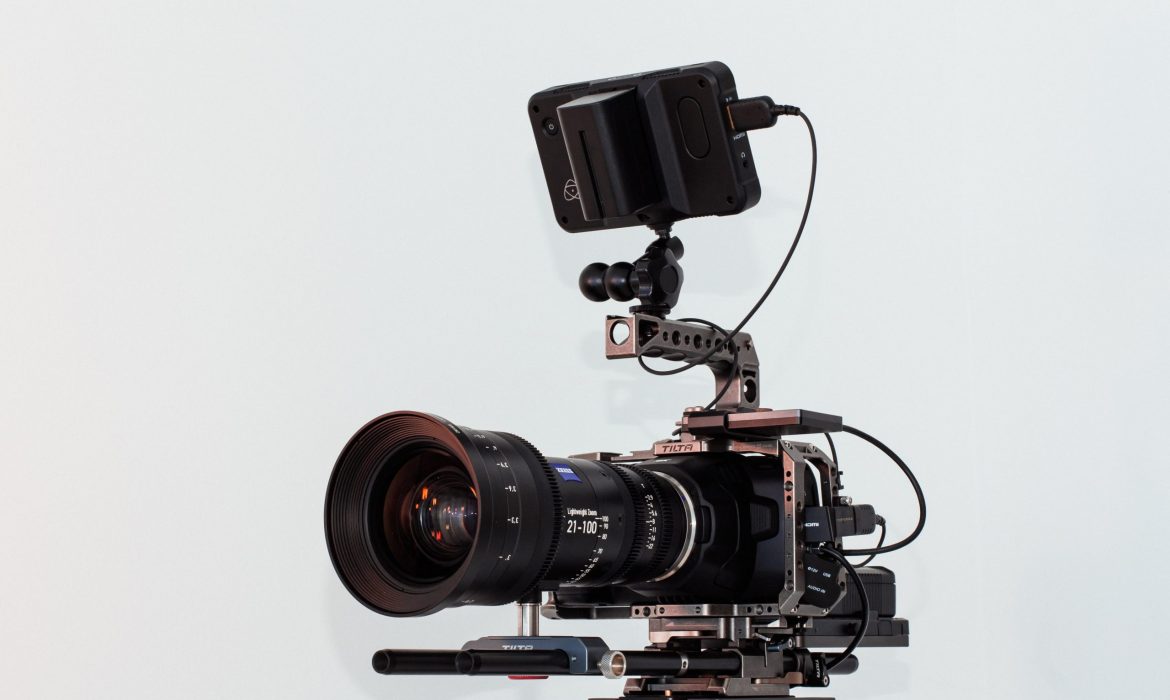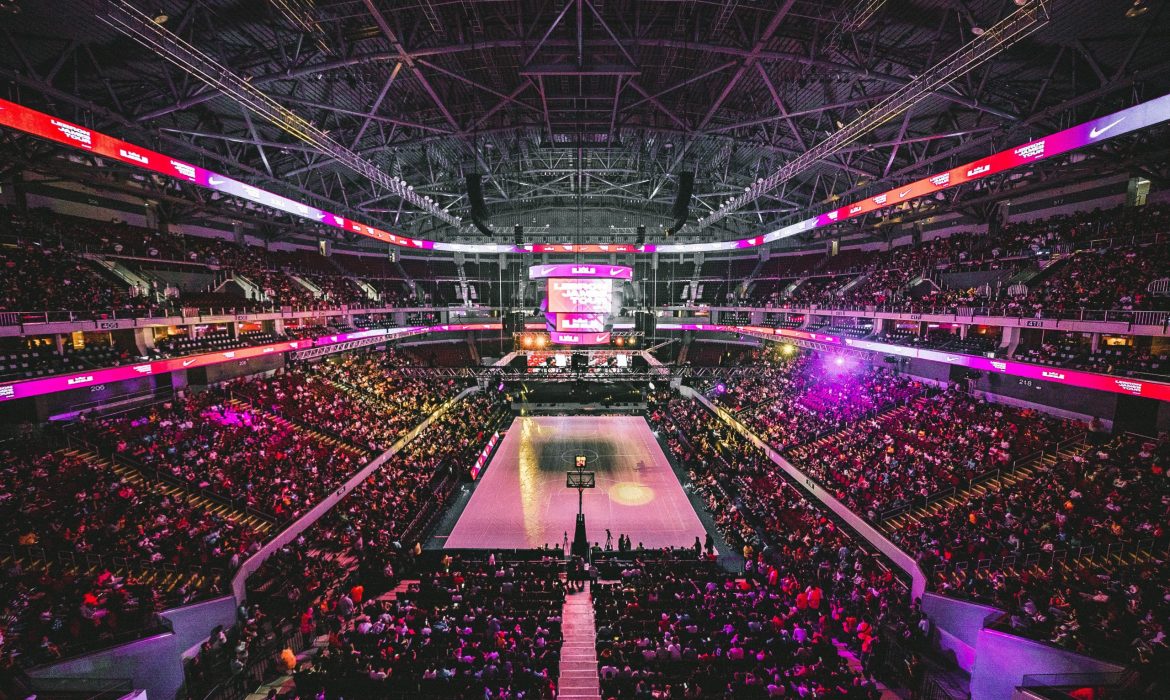Improve your social media stream with different content types
Remember when you had to buy an actual newspaper to see TV schedules? The good old days! Today’s world is completely the opposite, however: TV series, entertainment shows and sports events tempt you from each corner of the internet to watch them.
For broadcasters, this means you cannot simply wait for the viewer to come, because they have too much to choose from and too many other distractions. This leaves many broadcasters struggling for attention – a battle that’s impossible to win unless there is a willingness to adapt and offer more than traditional broadcasting.
Why adapt and offer something different? Let’s take a look.
The shift in attention
The data is ruthless: Gen Zers are rejecting traditional TV in favour of digital media[1]. There’s no doubt, change is in the air and there seems to be no way to reverse it.
But it’s not all doom and gloom – broadcasters just need to be prepared to try different mediums, but also to confront the demands of a different, more picky audience. The truth is that losing a viewer on the web is extremely easy, with potential viewers literally a click away from opening a new tab and moving their attention to a different place.

Broadcasters, especially those with experience in linear TV, are having to deal with this new shift, as well as learn new tools to manage the situation.
Social streaming is a great new tool in the box, but is it enough to grab attention for sustained periods of time? Especially when Gen Zers are notoriously less focused and easily distracted. The great news about Gen Zers though is that they are excellent at multitasking[3], which means they can watch a live stream, write comments and read articles at the same time!
So, if you decide to adapt to this new generation and the shift in attention, what are you going to offer? We already know that a social broadcast shouldn’t be a singular event. But what else should be part of the social broadcasting ecosystem? Next, let’s take a look at the essential ingredients.
The essential ingredients for successful social broadcasting
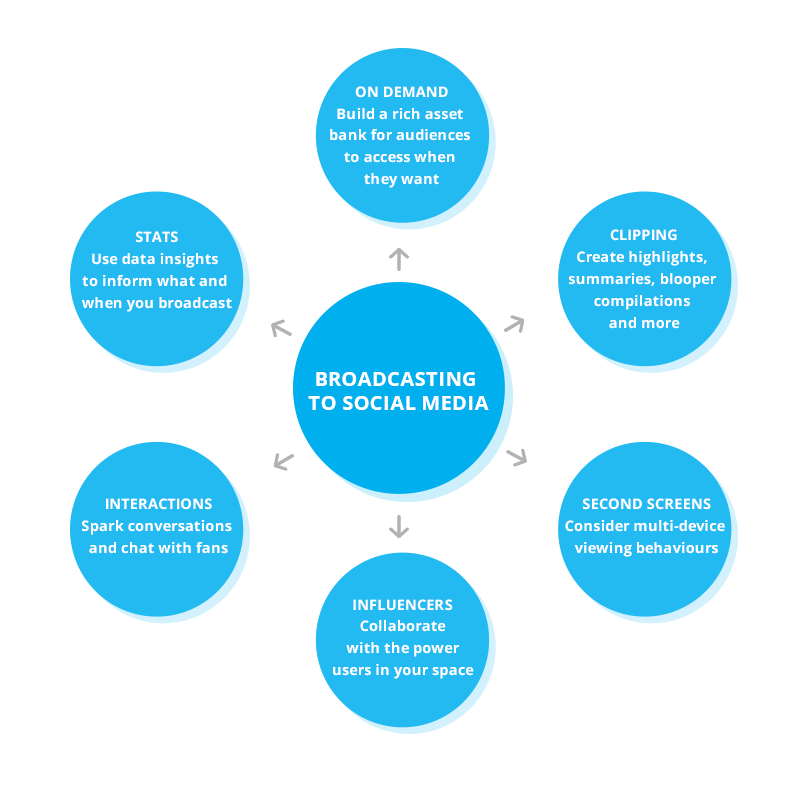
Clipping
This seems like a no-brainer, but it’s worth repeating. When streaming to a social media channel such as Facebook, keep creating and sharing bit-sized clips for those unable to watch the live stream itself. This is great for a number of reasons, as clips will help you to:
- Gain brand visibility inside and outside of your fan base.
- Increase all vital KPIs – views, reach, number of fans etc.
- Develop a rich bank of content you can upload to services like YouTube, Facebook or your own on-demand platform.
- Meet the demands of second screeners – who might be watching your live stream and catching/commenting on your clips, too.
Don’t avoid second screens – provide one!
To ‘second screen’ is to watch content on your TV and, at the same time, use a laptop or smartphone (the second screen) to check what’s going on in your social feeds, to message friends, use an app etc.
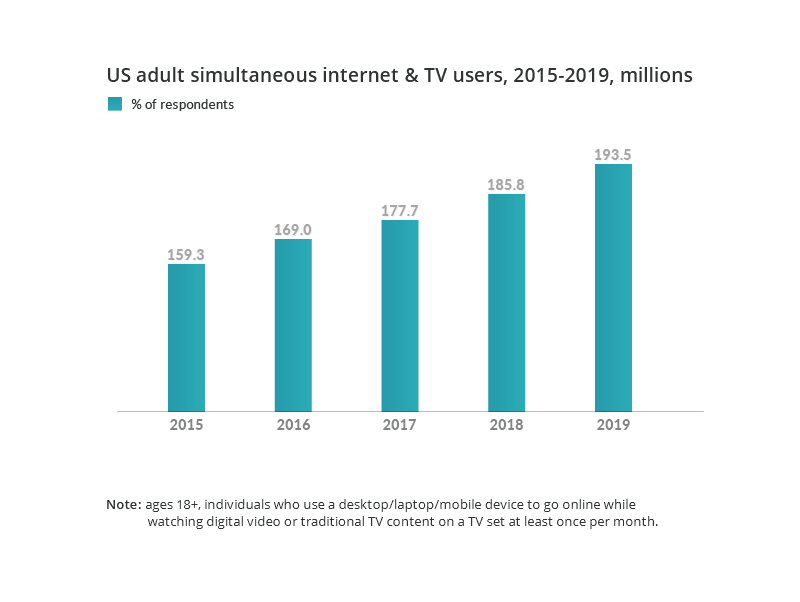
What’s in it for you? Out of 177 million second screeners in the US, 74% of viewers are interacting with unrelated content they see while watching a main event[4]. Your goal should be to make these people eager to see your content, instead of anything else.
Many second screeners are using Twitter to interact with their friends while watching a TV broadcast. They prefer to tweet, because the micro-blogging platform is quick and known for its promptness. Twitter has a 6% higher interaction rate for cross platform viewing among other social media platforms.[5]
The lesson to learn: While broadcasting, whether via a TV channel or a social stream, you should interact with your audience using other platforms. Use Twitter, Facebook or Snapchat and get involved with your audience. If you have your own mobile app, don’t hesitate to use push notifications to grab attention.
Mobile approach
Writing about the necessity of having a mobile app is soooo 2010, right? Well, it isn’t if you still don’t have one or you’re not using it properly. Mobile apps are a great marketing channel, especially if you have enough resources to keep it in good shape and your fan base is big enough to give you a good return on your investment.
How can you use a mobile app while being a broadcaster? You would use it just like any other marketing channel. But it has particular power if you treat it like an extra screen, content distribution tool and video streaming extension.
If you’re broadcasting whole TV programmes, include a calendar in the app, so your viewers can schedule reminders. If you’re streaming singular events, keep your fan base excited with news stories and premium video content available for app users only.
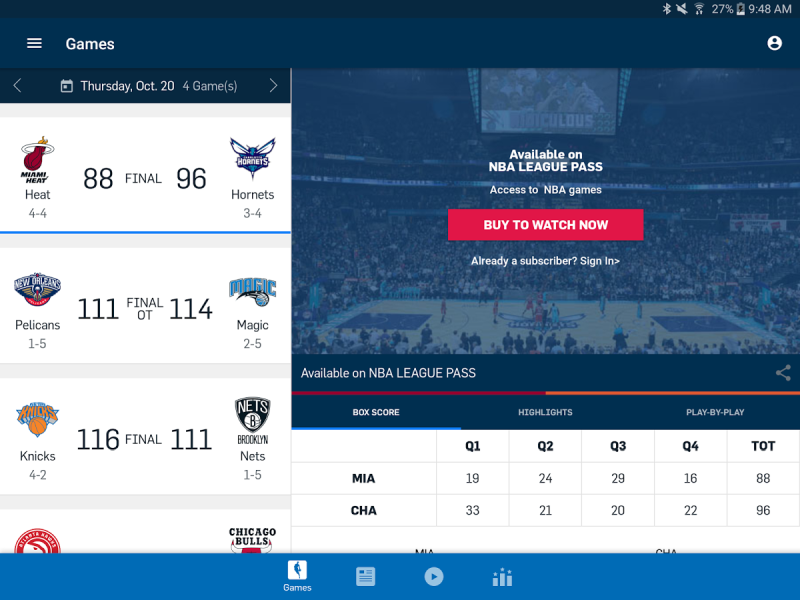
The NBA and NFL have both developed really good apps, providing live streams, video content, news and stats.
Stats and crucial details
Statistics and big data are extremely important, especially if you work in the sports broadcasting industry. Data is a gold mine for creating extra content for fans, such as stats, visualisations, comparisons, infographics etc… the list could go on.
Screen the data while broadcasting, but also create graphs, graphics and charts to publish on different social channels. Well prepared content will remain evergreen and live for a long time after its original use.
Collaborate with influencers
Collaborations with influencers in your space are a very modern solution. Essentially, by working with the movers and shakers in your environment, however big or niche they might be, will give you extra credibility and position your brand as an expert in your field.
You can collaborate with influencers in many ways: asking them for pre/post broadcast comments, involving them as expert panelists during streams, or by creating in-depth content in partnership. An influencer will provide expertise and give you a very specialised point of view.
Internet = social media
98% of people using the internet are social media users at the same time[6] – and there seems to be almost no life beyond Facebook, YouTube, Twitter or Weibo.
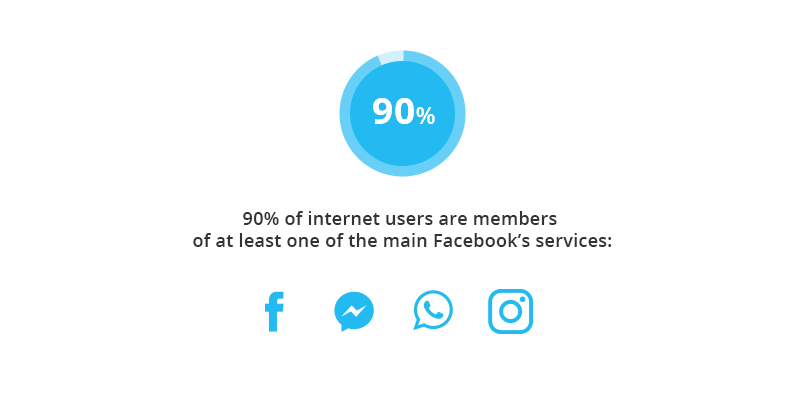
What this means is that your potential viewers are already on the web and probably on social media. As they’re already in these online spaces, you just need to reach them and spark interactions.
The good news is that potential viewers are likely to go where the good content is. So, alongside your awesome social broadcasts, share clips, create cool GIFs, publish polls, and ask your audience what they think and how they feel towards the content you’re sharing and what you’re saying – all the while encouraging conversations.
Go the extra mile!
Creating a wide range of versatile content can be time consuming and challenging. But, if done well, extremely rewarding at the same time. You might not have the budget and resources to cover all of the above solutions. But doing the social broadcast is surely the first step to take. Everything else is up to you!
[2] Nielsen Total Audience Report, Q1 2017. Daily time spent on TV, hr:min (Live+DVR/Time-Shifted): Generation Z, 2:18; Generation X, 4:38; Baby Boomers, 6:42
8 common live streaming mistakes that will create a horror show
Let’s face it, Halloween is a lot of fun. But only because it represents horrors that are not real. However, in the broadcasting industry real nightmares can happen, especially when live streaming to social media.
(By the way, have you seen the new Tellyo already?)
In this post, I’m going to run through the most common mistakes that will ruin your stream and scare off your audience.
Mistake #1: Being unprepared for technical difficulties

No matter how cool your event is, there are dozens of ways technical issues can wreck your stream. You can’t avoid equipment failure, nor repair an unpredictable internet outage. But you can think about providing alternative streams for users who are unable watch on Facebook or YouTube, for whatever reason. The same goes with streams at different qualities – depending on bandwidth, some users may want to skip 1080p and use 480p instead.
Think of alternatives to ensure your audience receives a broadcast one way or another.
Mistake #2: Not planning for when social becomes unsocial

When streaming content to platforms like YouTube, Twitter or Facebook you probably want to have as many viewers as possible, right? If so, the more people you attract, the more likely it is you’re going to draw the attention of people not always behaving properly or nicely. Trolls will be trolls, spammers will be spammers – but you must not let them take charge in a public chat or in your comments section. Put in place a moderator who can keep your broadcast free of these kinds of ‘users’.
The web is full of terrors trolls. Protect your audience from them.
Mistake #3: Failing to fill the gaps
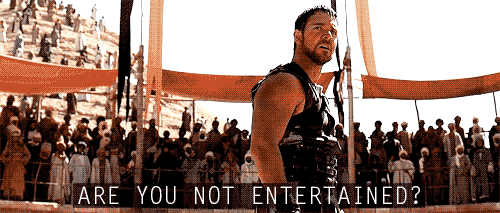
For every single digital broadcaster who’s streaming live sports – remember half time!
People will be watching your content for entertainment. When nothing is happening during the breaks, show them something. Think along the lines of previously prepared highlights, bloopers, statistics or interviews with players. Otherwise your audience will open a new tab to scroll their Facebook feed or to watch a music video on YouTube. Simply put – you’ll lose them.
[bctt tweet=”You can’t afford to bore your audience, so provide them with entertainment!” username=”TellyoTV”]
Mistake #4: Forgetting to chop and cut… content
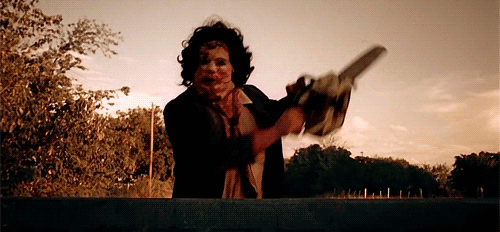
While live streaming, don’t forget about the people not able to follow your live stream, but who might be interested in what’s going on. Independent from your live broadcast, you should always clip and share highlights – such as goals, dunks and epic fails. This way, fans unable to catch the live stream can stay updated on what’s going on, and you can gain some extra views and reach.
Don’t stop creating content – the more clips you share, the bigger your audience will be.
Mistake #5: Not sending the memo!

No one will show up to your stream if you:
- Forget to post announcements before the actual event
- Plan the announcements too early or too late
- Spam your audience with waaaay too many announcements
You must remember to remind your users that you have a planned event, and make sure they are well informed about it.
Did you know that using Tellyo you can create Facebook announcement posts? These allow users to set reminders for events. How cool is that?
Mistake #6: Falling short when the end is nigh

The live broadcast shouldn’t be a singular event. It should be always preceded by announcement posts before the stream begins and not only on your chosen broadcast platform. During your broadcast, it’s also extremely important to produce short clips with highlights and replays, which will help drive new viewers to the live stream. Finally, after the broadcast, it’s your time to shine again – create highlights with summaries, clip compilations, top 5 plays etc.
Doing so, you will extend the broadcast from a one-off event to a longer, richer series of events focused on your main stream. Guess which one will attract more attention and viewers?
Tired of those scary horrors already? Try a love story instead!
Mistake #7: Being a silent (and creepy) administrator!

This is the face of someone who is streaming content to social media, but doing nothing more. He’s not taking part in discussions in comments section, he’s not answering questions, he’s not producing valuable content in the meantime and he’s definitely not a good example to follow.
Don’t be this guy!
Mistake #8: Missing your Frankenstein moment
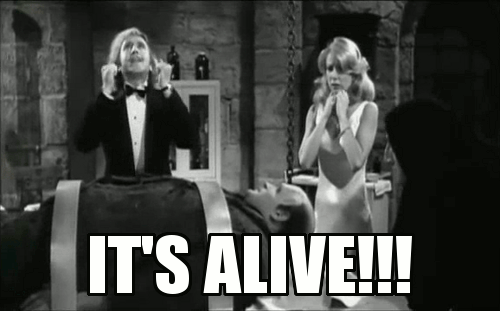
Don’t forget to be like Frankenstein and bring your old stream alive again. To do so, simply make the video content available to watch after the live event. Remember to choose the platform wisely – on Facebook and Twitter, your videos will almost be unsearchable and lost after only a couple of hours or days.
YouTube seems to offer the best solution in this respect, but you could go further and create your own video library for your viewers to watch on demand. You could even start with a simple landing page and videos embedded from the Tellyo player, helping you to increase web traffic or even monetise videos if the demand for your content is high enough.
Make content available in many forms after a live stream. Get more attention, and gain viewers and traffic with your ‘post-mortem’ content.
Wrapping up (like a Halloween Mummy!)
Don’t be the one to broadcast a horror show! For your own, and your audience’s sake, don’t make the above mistakes. And not only during Halloween!
A recipe for video content success: Lonzo Ball and the Summer League buzz
While it’s not everyone’s favourite, partly due to being played in the silly season, this year’s NBA Summer League was truly special. Lonzo Ball was the star earning MVP status on the court, while his father courted controversy off it. The surrounding buzz led to record viewing figures – with six of ESPN’s seven most-viewed games featuring the LA Lakers draft star.
ESPN proved willing to run with the Lonzo hype and the buzz his father, LaVar, was able to build around him. The channel struck gold with the duo, and their presence helped to build a buzz around the Summer League.
Some of the factors that helped build a buzz:
- A superstar in the making
There’s no doubt, Lonzo is a superstar on the rise. He has outstanding skill and is an unusual size for his position, which makes him an interesting proposition. It didn’t hurt that he brought passion and emotion to the court in front of big crowds in the stands and on TV, making him the Summer League’s Most Valuable Player.
- Lonzo, the lead story
Matching his performances, Lonzo maintained a position as the most written-about player throughout the Summer League. Media Cloud stats tell the story – he outpaced other players with 702 mainstream news stories, more than the 2nd and 3rd players combined.
- LaVar, a slice of controversy
There’s no doubt that “a ton of the attention Lonzo receives stems from his brash, outspoken father, LaVar,” according to a fantastic article on the FiveThirtyEight website. As he tried to bolster his family’s brand value any way he could, one of LaVar’s standout comments was to claim he was a better basketball player than Michael Jordan. Tweeters used #lavarballsays to mock him (ironically adding more fuel to the selfless promotion of the Ball name).
- The media were kept guessing
With Lonzo yet to sign a shoe deal with one of the major brands, masses of media attention surrounded what sneakers he would wear. This speculation was only encouraged by the Ball family releasing their Big Baller Brand shoes. So every time Lonzo put on a different pair of sneakers, people would be asking is it another marketing ploy?
What was the recipe for ESPN’s success?
ESPN fully capitalised on the buzz surrounding the Summer League. By combining TV broadcasts with video content and social media activity, the channel was able to engage its audience and even make some good gains. For example, 2017 Google Trends data shows huge increases in searches related to ‘NBA Summer League’.
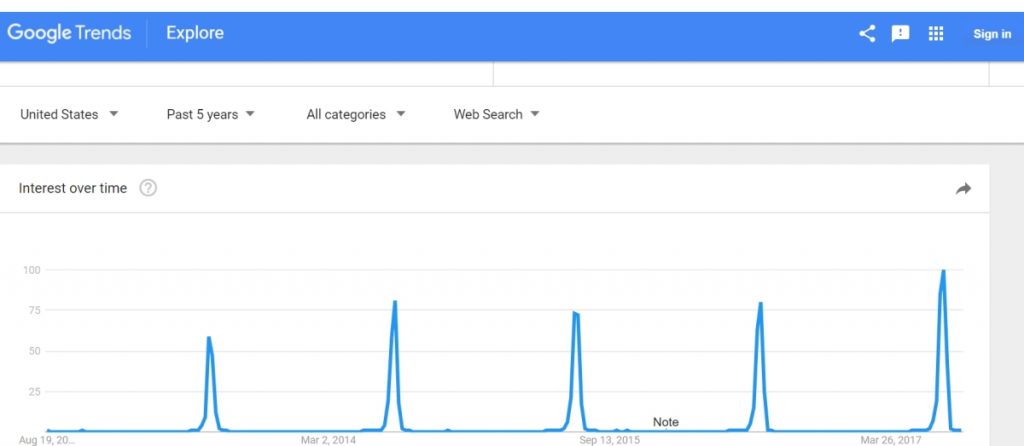
Google Trends for “NBA Summer League” term popularity
ESPN seemed to get its mix of ingredients just right.
- Great timing
The silly season is usually a bad time to break records. But the game between two great teams (Boston Celtics vs LA Lakers) and the duel between draft picks 2 and 3 (Lonzo Ball of the Lakers vs Jason Tatum of Celtics) presented opportunities for ESPN.
To hype the game, ESPN broadcasted a three-part documentary – Best of Enemies – exploring the Celtics/Lakers rivalry as part of its 30 for 30 series. The game itself was the most-watched Summer League game ever, with over 1.1million views on ESPN.
- Tons of shareable content dedicated to Lonzo Ball
Through content, ESPN were able to build a narrative thread that resonated with fans. It managed to maintain the hype surrounding the lead star, presenting Lonzo Ball as the future superstar and maybe as good as his father claims he is!
More than 1,000 articles and videos dedicated completely or partially to Lonzo or other Ball family members have also been created by ESPN.
- Big characters can add to the story
Lonzo Balls’ father, LaVar, was definitely one of the stars of the Summer League. You can dislike him, but the hype around his son is definitely his success. His opinions also get him airtime. On ESPN’s First Take Show, LaVar gets into a heated debate regarding his views on beating Michael Jordan in a game of one-on-one!
You may not have a Lonzo in your locker, or even want a LaVar on your team! But I hope you can take away some of the ingredients that created such a buzz around the Summer League and made it such a success.


